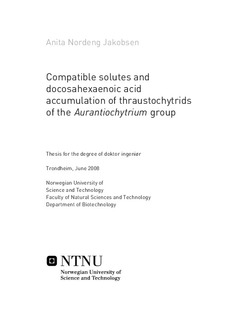Compatible solutes and docosahexaenoic acid accumulation of thraustochytrids of the Aurantiochytrium group
Abstract
Docosahexaenoic acid (DHA; 22:6 n-3), a polyunsaturated fatty acid (PUFA), is linked to various health benefits in humans including cognitive and visual development of infants and reduced risk of cancer, cardiovascular diseases and mental illnesses of adults. Fish
oil, with an annual production of about 600,000 tons is at present the major source of DHA. However, the production of fish oils is expected to become inadequate for supplying an expanding market within few years. Thraustochytrids are marine heterotrophic producers of PUFA-rich triacylglycerols which represent an alternative source of DHA.
The focus of this thesis has been split between a basic study of the osmolyte system of traustochytrids and work towards an understanding of their growth kinetics, effects of nutrient depletion, and lipid and DHA accumulation. Three new osmotolerant thraustochytrid isolates (T65, T66, and T67) and the previously known Schizochytrium sp. strain S8 (ATCC 20889) were assigned to the genus Aurantiochytrium based on 18S ribosomal DNA phylogeny, morphology and PUFA profiles (approximately 80% DHA). Strains T66 and S8 displayed a nearly linear increase in cellular content of endogenously synthesized (-)-proto-quercitol and glycine betaine with increasing osmotic strength. This represented the first demonstration of accumulation of principal compatible solutes in thraustochytrids. A less osmotolerant isolate (Thraustochytriidae sp. strain T29), which was closely phylogenetically related to Thraustochytrium aureum (ATCC 34304) did not accumulate glycine betaine or (-)-proto-quercitol, illustrating a variation in osmolyte systems and osmotolerance levels among thraustochytrids.
To study the effects of nutrient limitations, Aurantiochytrium sp. strain T66 was grown in batch bioreactor cultures in a defined glutamate and glycerol containing medium with various medium limitations. N and P starvation and O2 limitation initiated lipid accumulation. N starvation alone or in combination with O2 limitation yielded the highest lipid contents obtained in this study, i.e., 54 to 63% of cell dry weight with a corresponding cell density of 90 to 100 g l-1 dry biomass. The DHA-content of N starved cells was 29% of total fatty acids, while O2 limitation increased the DHA-content up to 52%. Simultaneously, O2 limitation abolished accumulation of monounsaturated fatty acids. We inferred that the biological explanation is that O2 limitation hindered activity of the O2-dependent desaturase(s) responsible for production of monounsaturated fatty acids, and favored the O2-independent PUFA synthase. The highest DHA-productivity observed was 93 mg l-1 h-l, obtained during sequential N starvation and O2 limitation. This
productivity approaches the highest values previously reported for thraustochytrids, and indicates that T66 may become a candidate organism for a future large-scale microbial PUFA production process.
